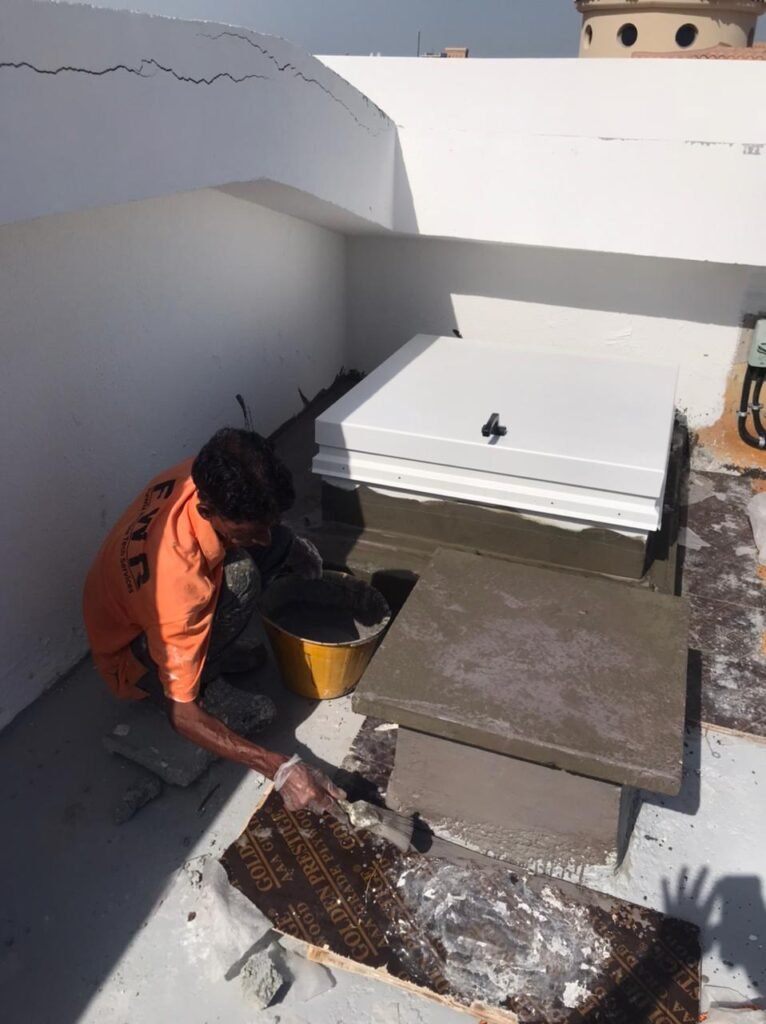Introduction
Dubai is a city with breathtaking structures built at a very rapid pace. One of the critical ones refers to the use of effective waterproofing methods in Dubai considering that it is a high-humidity city with the occasional downpour and its closeness to the sea. Although annual precipitation levels are low, infiltration of moisture is a significant problem for buildings, necessitating the consistent need for reliable waterproofing for structural integrity over the long term. In this article, we’ll explore Waterproofing methods in Dubai.
The Importance of Waterproofing in Dubai
Among various factors, the following highlight their significance:
- The underground structure must be shielded against the desert environment, which fluctuates drastically between day and night.
- Our geology comprises mainly soluble rock; hence, the chance of water seeping in is high.
- In this case, “water” is also what we put in fountains, birkats, and swimming pools.
1. Climate Challenges: Extreme temperatures in Dubai can cause building materials to expand and contract. This movement can create cracks and gaps that allow water to infiltrate.
2. Intense Downpours: While Dubai is mostly arid, it does have occasional downpours, especially in winter. When they occur, these relatively brief storms can unleash a lot of rain. They can also lead to urban flooding because intense rains tend to overwhelm wintertime drainage systems. Waterproofing, therefore, is a necessity.
3. Groundwater: Despite its desert environment, Dubai has several aquifers that can supply water to the surface. The water table, however, is quite shallow. One source puts it at a little over 500 meters below the surface. Sea water intrusion is a real threat. Another reason to waterproof.
4. Humidity: The region’s elevated humidity can result in condensation and moisture accumulation that may harm building materials and compromise structures. Moisture build-up can also support mold growth.
5. Saltwater Exposure: As a city by the sea, we have many structures that are out in the saltwater, and that can lead to corrosion of materials and a compromise of structural integrity, especially over long periods.
6. Regulatory Compliance: The Dubai Municipality enforces rigorous building codes and regulations that mandate efficient waterproofing solutions to safeguard buildings and public works from moisture damage.
Common Waterproofing Methods
There are a number of waterproofing methods in Dubai that are used, with each one specifically matched to its own distinct application.
1. Membrane Waterproofing
Waterproofing a membrane means placing a very thin layer of waterproof material over a surface to make it waterproof. It can be performed by applying waterproofing membrane materials by hand using tools like: Brush, Trowel, and Roller or by using mechanized spray equipment to apply the spray-grade waterproofing membrane material.
- Bituminous Membranes: These are materials based on asphalt, which offer remarkable waterproofing capabilities. These are extensively used for roofing and foundational structures.
- PVC and TPO Membranes: These thermoplastic materials are lightweight and durable, making them suitable for flat roofs and commercial buildings.
2. Liquid Waterproofing
Waterproofing using liquid involves the application of a liquid coating that cures to form a seamless, waterproof membrane. This method is ideal for complex surfaces and areas with intricate details.
- Coatings of Polyurethane: These are flexible and can withstand temperature fluctuations, making them suitable for roofs and balconies.
- Acrylic coatings: These are exterior-grade, UV-treated coatings. They are often used in metal and wood applications. They are, generally speaking, not waterproof. However, they work quite well in areas that do not see excessive moisture. They are not mold resistant, which is disappointing. Nevertheless, they are quite durable and an excellent choice for low-risk areas where the finish will be safe from drips.
3. Cementitious Waterproofing
Waterproofing with cement uses a blend of cement, sand, and other substances to form a waterproof barrier or membrane. This approach is commonly employed in the following scenarios:
- Cellars: To stop water from coming in from the ground.
- Tanks for Water: To guarantee that the water stored in them is free from contamination.

4. Crystalline Waterproofing
The technique makes use of special chemicals that combine with moisture to form crystals within the concrete, blocking the pathways that lead to water. This technique is most effective with:
- Structures of Concrete: Such as bridges and tunnels, where long-term durability is of the utmost importance.
Waterproofing Materials Available in Dubai
The market in Dubai provides a diverse selection of waterproofing materials that suit many different requirements and budgets.
1. Liquid Membranes
Different formulations are available, including options based on polyurethane or silicone. Both works well in home and business settings.
2. Sheet Membranes
These pre-formed sheets are simple to put in place and supply trustworthy water-tightness. They find their typical application in roofs and places below the ground.
3. Cementitious Products
Among them are compounds for waterproofing that can be blended with cement to make it suitable for use in such places as basements and water tanks, and for other kinds of construction. Yet another category of admixtures is made up of those that increase the workability of concrete.
4. Sealants and Caulks
These materials seal joints and gaps in structures, keeping water out. They are critical for all kinds of openings in a building, including windows and doors.
Best Practices for Waterproofing in Dubai
For effective waterproofing in Dubai, ensure you do the following best practices.
1. Carry Out a Detailed Evaluation: Before utilizing any waterproofing remedy, perform a meticulous evaluation of the space to discover possible weaknesses and places where moisture may be entering.
2. Choose the Correct Materials: Pick waterproofing materials that are appropriate for the specific application and environmental conditions. Think about attributes like resistance to UV rays, flexibility, and durability.
3. Correct Setup: Make sure that the manufacturer’s instructions are followed exactly when installing waterproofing products. If products are improperly installed, they may fail far too soon and need to be replaced, which can be a very expensive proposition.
4. Routine Upkeep: Establish a routine upkeep timetable to check and care for waterproofing systems. This is especially important after the systems have been put through the wringer by unusual weather, such as heavy rainfall or extreme heat.
5. Obtaining Professional Help: Think about employing waterproofing contractors who are professionals and have experience with the local area. They know the regulations and have the kind of insights that make the process go smoothly and result in high-quality work.
Conclusion
Making structures waterproof is crucial in construction and building maintenance in Dubai, which faces uniquely challenging conditions. Knowing why waterproofing is important, what waterproofing methods in Dubai are available, and what the best practices are can protect a property investment long enough to promise an appearance of sustainability. Even as Dubai keeps building and reinventing itself, the effective waterproofing of its structures seems to be one sure thing that will keep Dubai’s urban landscape looking fresh.
Don’t procrastinate and risk waiting too long! Contact us today for an array of waterproofing services that will safeguard your property well into the future.
